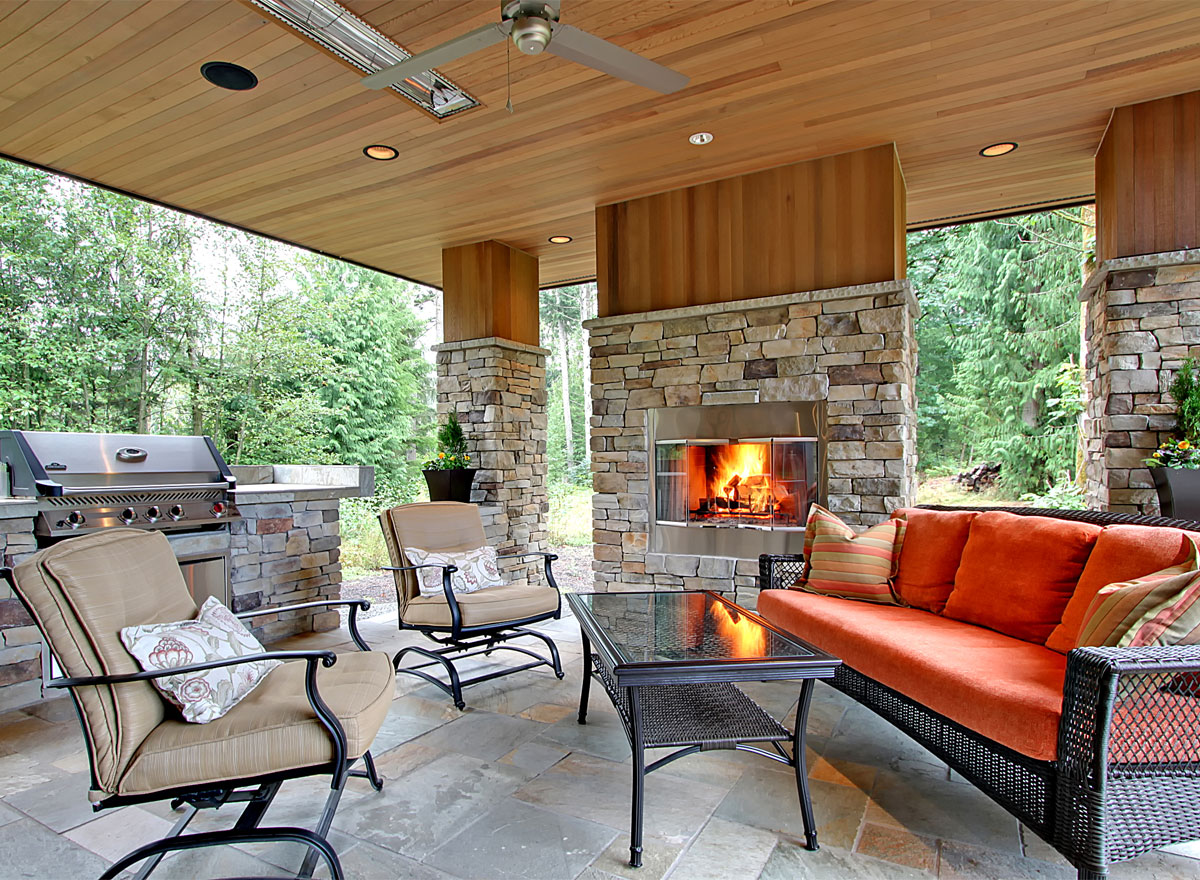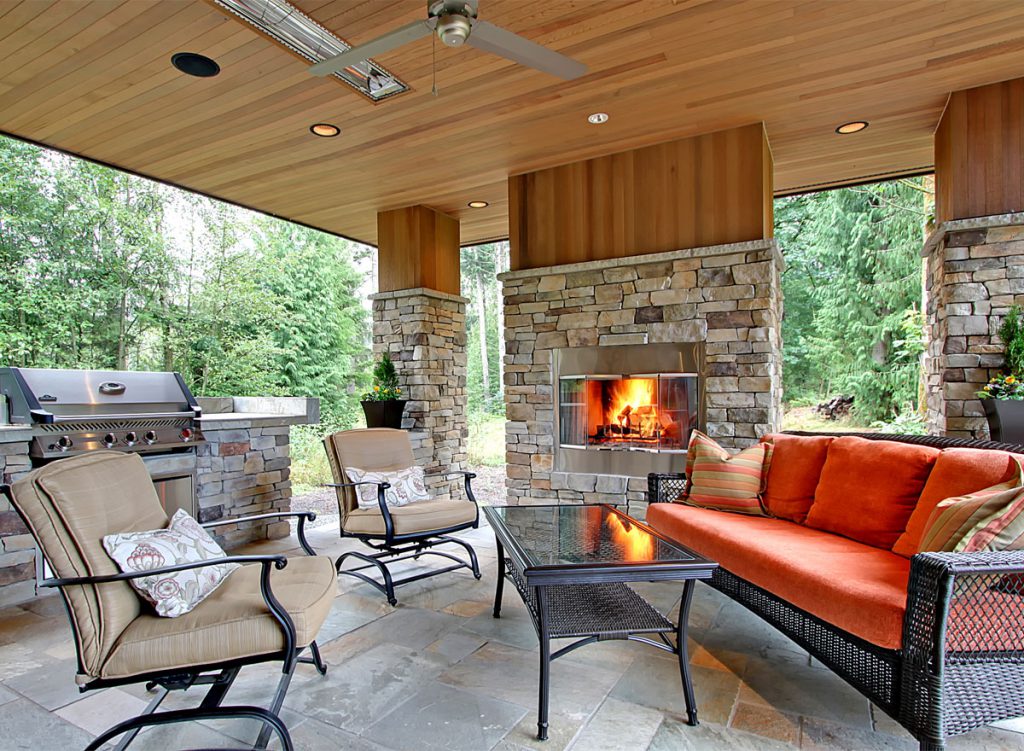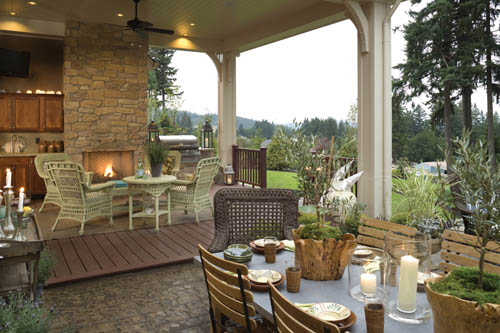
If you love sunny days, warm summer nights, or hosting big gatherings of friends and family, maybe the thought of an outdoor kitchen has crossed your mind before. More than just a grill that you pull out of the garage for cookouts, this amenity is growing in popularity as people want to extend their living spaces and add a new level of convenience to their lives. What could be better than getting out of the kitchen to prepare a meal when the weather is so nice that the last thing you want is to stay inside?
The House Designers offers plenty of homes with outdoor kitchens included in their designs—take a look at the Outdoor Living House Plan Collection to find everything from simple patios to fully loaded backyard cooking stations. It’s not difficult to modify a blueprint or even plan to renovate the exterior of your existing home to give it a beautiful and functional kitchen that will have you spending as much time as possible enjoying your property through the seasons. Here are a few things you should think about if you’re considering this major upgrade that that will boost your home’s value and improve the time you spend there!
House Plan 3346 features an open outdoor covered living space with cooking area and stone fireplace.
The Advantages of Cooking Outside
There are many reasons why outdoor kitchens are quickly becoming a must-have feature in new construction. Just about everybody can appreciate something about them, whether the benefits are seen on a small or grand scale.
Believe it or not, the day to day pluses of having an outdoor kitchen often outweigh the obvious advantages during parties that people imagine first. For instance, think of all the foods you love to eat but that you don’t want lingering for days in your home—you can prepare them in a place with much better ventilation to make sure that smells don’t get trapped inside to remind you of dinners from days past. So take your fish and bacon outside, where their distinctive aromas can waft away, and you can enjoy them and still keep your home smelling fresh.
House Plan 8292 features a beautiful outdoor living space complete with kitchen area, fireplace and covered patio with dining area.
In the warmer months, when you’re most likely to want to cook outside, choosing to do so can actually have an effect on your utility bills. It’s not just that you’re switching from an electric stove to a gas grill—the heat produced by your appliances can increase the indoor temperature by some degrees, and then your air conditioning kicks in stronger to counteract it. If you cook often, you could drop your electricity usage and save some cash by moving it outside.
Finally, most people know that cooking in the backyard is a great way to host a party. You can fit more people in an open space comfortably, and easily converse with guests when you aren’t cramped and crowded in a kitchen that becomes claustrophobic when people are over. You want to increase the comfort factor for everybody and still have fun as a host, and the most efficient way to do that is to move to a wider area. Even a small home can support a large gathering when you use your whole property! And cleaning up afterward is so much easier, too.
House Plan 5202 features a large outdoor living space including a full kitchen enclosed with stone, covered patio with fireplace with casual seating and television and dining area.
Design for Safety and Convenience
When you’re designing your own outdoor cooking space, you probably want to make it a full, standalone kitchen. Regular indoor kitchens have become such a focal point of new homes that they are usually positioned in the front or middle of the house, where they are noticed immediately. It’s likely that it doesn’t directly join to the back yard, which would make doing prep work inside and passing dishes out to the grill feasible. You don’t want to have to carry heavy trays through a party to be prepared and then back again for cleanup—it would be much better to have it all done in the same place!
We’re seeing more and more appliances being made specifically for outdoor installation. You can find everything you need to create your own perfect kitchen—grills in all sizes, under-counter refrigerators, and even pizza ovens! Think about what you might want to include in your design so you can plan with all the pieces in mind. Consider the amount of patio you have to work with, too, to make sure everything will fit. Even if it looks tight, don’t fret! You can put in an island to give you more counter space, and even shift the grill there so you can put on a show like a celebrity chef.
Most outdoor kitchens are covered, at least in part. Especially if you go all-out, you probably don’t want to see it rain on your cabinets, no matter what they’re made of. It’s common to place the sink and any non-grill appliances under an overhanging eave if not a full canopy. Grills come with covers, so you don’t have to worry about them, and you should use them away from the house, anyway. Prioritize ventilation to make sure your kitchen is safe. Take a hint from the hood over your stove inside; you want heat and grease to be carried away.
Choosing Suitable Products
With everything you’re putting into your outdoor kitchen, you definitely want it to last. Many people think it seems too costly and risky to make this investment considering that it will be exposed to the elements, but all you have to do is make smart choices about materials and you’ll be surprised by just how enduring it can be!
First of all, stainless steel is the go-to choice for appliances, so you’ll get a crisp, clean look to build around. You can also find stainless steel storage drawers for any tools or spices that you want to keep handy, because it would get old real fast if you had to carry things out and have them clutter your workspace whenever you wanted to cook. Of course, you’ll find cabinets of this material as well—and if this seems like a lot of metal, rest assured there are options! Different door styles, with solid colors or even woodgrain patterns, are available, so you can combine durability with style. Depending on your climate, you might even be able to use real wood; there are a few very weather-resistant species available, and you can find them from specialty outdoor cabinet makers.
When it comes to countertops, natural stone isn’t automatically the best option. Porous types will stain and fade in the sun, but granite can be a good choice so long as it isn’t heavily veined, because the fillers used to seal it react with UV rays. There are also tiles made for exterior use, but be aware that grout stains easily and think about using a darker color for it. Concrete counters are a very popular choice with unlimited color options, but they prone to cracking. A trustworthy, knowledgeable manufacturer and regular resealing can prevent this and protect your investment. Whatever you choose, pick a medium color—too light and it’ll readily show dirt and wear, and if it’s too dark, it’ll get very hot in the sun.
If you’ve been inspired to add an outdoor kitchen to your home, be sure to consult with a professional. You want to make sure that all the components you choose will work with your environment. From blaring sun to freeze and thaw cycles, there are many variables to weigh as you decide on what to use and where to put it. But once you figure it out, you will be ready to appreciate all the benefits that an outdoor kitchen brings to your home!
- The House Designers Supports Hurricane Harvey and Irma Relief Efforts - September 25, 2017
- Tiny House Plans Go Mainstream - October 8, 2016
- 10 Mistakes People Make When They Build Their Own Homes - June 24, 2016



.jpg)